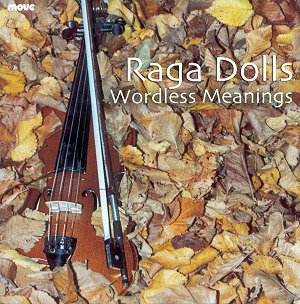The instrumental layout of this CD is the clue as to what to
expect. The rather slight CD booklet says the rest. David Osborne writes
"Raga Dolls is one of a number of groups currently helping to revive
the forgotten tradition (of salon ensembles) but in two important ways
we have more in common with modern day rock bands, we include a high percentage
of original material in our repertoire, and secondly, our name has absolutely
nothing to do with the music we play" (i.e. Indian Ragas!}
So to name the music on this CD in the usual manner
would entail titles like Tango; ‘Still Life’, Tango (again), ‘Left at
Carlisle’, oh and another Tango.
In his very brief notes on each composition Osborne
has given us the background to each piece, although for the opening
Tango he rather unhelpfully points out that "the name says it all".
Of the second track ‘At the Nest’ he says, "Sounds like traditional
Irish but it’s actually contemporary American Folk" (I’m glad he
thinks so. It didn’t come across to me like that). For Track 4 ‘Still
Life" he writes "Initially this was the middle section of
a pop song I was writing. I wonder if this sounds like classical music?"
Late on track 10 for an arrangement of Schubert’s song ‘Ständchen’
he chirps, "People tend to get carried away when describing this
most inspired music…" Finally for track 11 Hungarian Dance No.
5 he comments, "I think Johannes Brahms had something to do with
this one". Needless to say his commentary is aimed at people who
don’t like reading programme notes. They are mostly slightly irreverent,
tongue in cheek and I suppose typical of this sort of ‘crossover’ album.
Other classical pieces used are Massenet’s ‘Meditation’, very beautifully
done and ‘Du Bist die Ruh’ which sounds here like a country and western
number and is sung by a voice which sounds totally uninterested in what
it is doing. I can only say that I am relieved that Caroline Craig makes
no other appearances on the recording. There is also an attractive arrangement
of the Intermezzo from ‘Cavalleria Rusticana’ and the Intermezzo from
‘The Gadfly’ by Shostakovich. Let me briefly describe the sound of one
of the tracks ‘Destiny’ a Waltz by Sydney Baines: melody in the accordion
moving between various octaves, doubled by the violin or accompanied
by broken chords. This is repeated with parts reversed. There are accompanying
harmonies on banjo and/or guitar. The bottom part is on bass, very simple
and delightful. The middle section melody is high on the guitar with
light accompanimental figures on the accordion and tremolando violin.
Incidentally, this track, like a couple of others is too long for the
material. Everyone is suitably occupied in a role; all of which suits
the salon set-up.
You will have gathered from the above that we have
here a very wide range of styles that will have an appeal to a wide
variety of listeners. For myself I have to say that sometimes I felt
that I had inadvertently stumbled into BBC Radio 2’s Sunday evening
edition of ‘Sing Something Simple’ without the Mike Sammes Singers.
At other times I was charmed by the arrangements and the effortlessly
beautiful ensemble and tone quality. I am secure in the knowledge that
my mother would really enjoy this CD. There is a place for this music
but definitely not on my shelves.
Gary Higginson


